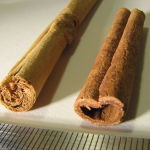by Cat, Aug 2007. updated May 2021 (Photo, right, from Wikimedia Commons)
See also: Individual Herbs & Spices, A – F, which includes discussion of cinnamon.
Traditional medicinal uses of the two main varieties of cinnamon:
- In traditional Chinese medicine, Cassia cinnamon is used for colds, flatulence, nausea, diarrhea, and painful menstrual periods.
- In traditional Indian medicine (Ayurvedic), true cinnamon is used as a remedy for type-2 diabetes/insulin resistance. The scrolled bark for both is pictured in the photo, above right.
Cinnamon vs cassia for treatment of blood sugar/insulin resistance issues
The best cinnamon for controlling blood sugar/insulin resistance is Ceylon (Cinnamomum zeylanicum) or true cinnamon (Cinnamomum verum). It has less of the toxic components and more of the insulin affecting components. Ceylon cinnamon is available at several online sources including Amazon. I get a special order from Swan Valley Herbs in Bigfork. The standard dose is ½ tsp ground cinnamon = 5 grams cinnamon (see below for how best to take this remedy).
The other common species is called Cassia, which has higher levels of the potentially toxic coumarin (cinnamaldehyde), and lower levels of the substances that help control blood sugar and increase insulin sensitivity. Other names for Cassia: Cinnamomum cassia (aka Cinnamomum aromaticaum) and Cinnamomum burmannii. I do not recommend Cassia for insulin sensitivitey/blood sugar control because of its toxicity to the liver (due to higher levels of the toxin coumarin). However, it has a stronger flavor than true cinnamon, so I often use it in cooking – or use part true cinnamon, part cassia if I want both the flavor and the blood sugar benefit.
If you buy them as sticks, you can tell them apart (see photo, above right):
- True cinnamon is rolled as a single roll;
- Cassia is rolled from both sides toward the center, like a scroll.
As powders, it is difficult to distinguish them (although true cinnamon is fluffier, less aromatic, and not as red), so best to contact the manufacturer if the species name is not provided.
Active components & Cinnamon/Cassia toxicity:
Both cinnamon and cassia contain aromatic oils known as cinnamaldehyde and coumarin. Beware: concentrated extracts of these oils can be quite toxic to the liver, and act as blood anti-coagulants; thus it is far better to consume the whole spice, as in cooking. (1, 2). Or make a water extract or drink a cinnamon tea.
Water-soluble cinnamon extract for blood-sugar control; cinnamon tea
The active ingredient affecting insulin sensitivity is hydroxychalcone, which is predominately found in the water-extract of Ceylon cinnamon (2, 5). One way to take a water extract of Ceylon cinnamon is as a tea (16). Or you can make your own water extract to avoid the toxicity of other components in the oil-extract. This is advised if you take more than ½ tsp cinnamon daily. Water extract recipe:
- Spoon 4 tsp (8 half-tsp) ground true (Ceylon) cinnamon into a small jar.
- Add ½ cup filtered water, stir, then let rest until the liquid separates.
- Pour through a paper coffee filter set in a funnel. Keep the liquid and toss the sediment.
- 1 Tbsp cinnamon water provides the water soluble portion of 1/2 tsp cinnamon.
For more on cinnamon toxicity, see: WH Foods (3, 4) and Health Compendium (5).
How true cinnamon works to control blood sugar:
Cinnamon works to control blood sugar on several levels, according to Dr Mercola (7) by slowing the emptying of the stomach to reduce sharp rises in blood sugar following meals; by improving the effectiveness (sensitivity) of insulin; and by enhancing antioxidant defenses.
Furthermore, the improvement in insulin sensitivity can lower blood pressure and improve a lipid panel (lower total cholesterol and LDL, while raising HDL).
References
NOTE: Dec 2021, I discovered several of the links in the list are no longer valid, so I crossed them out. I am still working on replacement links.
- (9) The Epicenter on Cassia (theepicentre.com/Spices/cassia.htm)
- (12) Life Enhancement.com on blood sugar and cholesterol-lowering effects of cinnamon (life-enhancement.com/article_template.asp?ID=914)
- (13) Sadly, whfoods.com is no longer a valid site. Thus, all their links included in 3a, below are no longer valid. Thankfully, I’ve found another site that is still valid (3b, below)
Cinnamon (whfoods.com/genpage.php?tname=foodspice&dbid=68); on Cassia vs Cinnamon (whfoods.com/genpage.php?tname=newtip&dbid=31); on cumin (whfoods.org/genpage.php?tname=foodspice&dbid=91)- Replacement link: For more about Cassia vs Ceylon cinnamon, try: preventdisease.com/news/14/033014_Make-Sure-The-Cinnamon-You-Are-Purchasing-Is-Not-Irradiated-and-Not-Cassia.shtml
- (14)
Health Compendium on cinnamon toxicity (health-compendium.com/index.php?option=com_content&task=view&id=30&Itemid=9)This one is also no longer valid - (15) Diabetes Health on cinnamon (diabeteshealth.com/read/2004/11/01/4013/cinnamon); while diabeteshealth.com is still valid, this particular link is not; I’ve not yet found its replacement
- (16) Alternative Medicine on cinnamon tea (altmedicine.about.com/od/cinnamon/r/cinnamontea.htm) (this link is still valid)
- Mercola on 10 top healing spices. Sadly, he has closed down all his old articles, and only keeps his new articles up for 3 days.
(articles.mercola.com/sites/articles/archive/2008/08/21/top-ten-spices-that-defend-you-against-aging.aspx) and on holiday spices (mercola.com/2003/dec/13/holiday_spices.htm)

